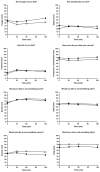Effect of Sugar-Free Jelly on Glycemic Metabolism and Its Potential Health Benefits in Non-Diabetic Adults
- PMID: 38540910
- PMCID: PMC10969550
- DOI: 10.3390/foods13060920
Effect of Sugar-Free Jelly on Glycemic Metabolism and Its Potential Health Benefits in Non-Diabetic Adults
Abstract
Excessive sugar consumption provides energy but has little nutritional value, contributing to the prevalence of obesity. Hence, "sugar-free" products using artificial or natural sweeteners, including sugar alcohols, have become popular. Accordingly, safety concerns and curiosity have arisen. Therefore, this study used a double-blind, crossover design to compare the effects of commercial sugar-free and sugar jellies (control) on the glycemic response in 16 adults without diabetes. Blood samples were collected to measure blood glucose, insulin, glucagon, ghrelin, C-peptide, glycated hemoglobin, and glycated albumin levels, and an oral glucose tolerance test was performed. Questionnaires on satiety and intestinal health were also administered. Sugar-free jellies resulted in significantly lower glucose and insulin levels and a reduced area under the curve while showing higher glucagon levels than the controls. Moreover, the sugar-free jelly initially resulted in the greater secretion of ghrelin; however, after 2 h, the control jelly resulted in higher ghrelin. No significant differences were observed in gut quotient, C-peptide, glycated hemoglobin, and glycated albumin levels. In conclusion, substituting sugar jelly with sugar-free jelly may induce lower blood glucose and insulin levels and higher glucagon levels, indicating a better ability to control glucose metabolism. Appetite was not stimulated by sugar-free jelly consumption.
Keywords: appetite; glucose metabolism; glycemic control; polyol; sugar alcohols; sugar-free.
Conflict of interest statement
M.G., H.S., H.J., W.J.Y. and G.H.L. are employed by Lotte R&D Center. M.G., H.S. and H.J. were involved in the product preparation and packaging of both the experimental and control jelly and delivered the products to the testing site. In addition, they were involved in blinding to avoid and prevent conscious or unconscious bias until the end of study. G.H.L. and W.J.Y. recruited the local hospital where the study was performed. They declare no conflicts of interest. The other authors declare no conflicts of interest. The authors declare that this study received funding from LOTTE Well food. However, the funders had no role in defining the study design, in the collection, analysis and interpretation of data, in the writing of this article and in the decision to submit it for publication.
Figures






Similar articles
-
Satiety, glycemic profiles, total antioxidant capacity, and postprandial glycemic responses to different sugars in healthy Malaysian adults.Nutrition. 2022 May;97:111551. doi: 10.1016/j.nut.2021.111551. Epub 2021 Nov 27. Nutrition. 2022. PMID: 35217298
-
The Effect of Coconut Jelly with Stevia as a Natural Sweetener on Blood Glucose, Insulin and C-Peptide Responses in Twelve Healthy Subjects.Recent Pat Food Nutr Agric. 2018;9(2):127-133. doi: 10.2174/2212798410666180717163852. Recent Pat Food Nutr Agric. 2018. PMID: 30019656
-
An enriched, cereal-based bread affects appetite ratings and glycemic, insulinemic, and gastrointestinal hormone responses in healthy adults in a randomized, controlled trial.J Nutr. 2015 Feb;145(2):231-8. doi: 10.3945/jn.114.200386. Epub 2014 Dec 10. J Nutr. 2015. PMID: 25644342 Clinical Trial.
-
Is glycemic index of food a feasible predictor of appetite, hunger, and satiety?J Nutr Sci Vitaminol (Tokyo). 2009 Jun;55(3):201-7. doi: 10.3177/jnsv.55.201. J Nutr Sci Vitaminol (Tokyo). 2009. PMID: 19602827 Review.
-
Effect of sucralose and aspartame on glucose metabolism and gut hormones.Nutr Rev. 2020 Sep 1;78(9):725-746. doi: 10.1093/nutrit/nuz099. Nutr Rev. 2020. PMID: 32065635 Review.
References
-
- Olivia Lawe Davies C.L. WHO Calls on Countries to Reduce Sugars Intake among Adults and Children. [(accessed on 7 November 2023)]. Available online: https://www.who.int/news/item/04-03-2015-who-calls-on-countries-to-reduc....
-
- Jayalath V., de Souza R., Ha V., Mirrahimi A., Blanco-Mejia S., Di Buono M., Jenkins A., Leiter L., Wolever T., Beyene J. Sugar-sweetened beverage consumption and incident hypertension: A systematic review and meta-analysis of prospective cohorts. Am. J. Clin. Nutr. 2015;102:914–921. doi: 10.3945/ajcn.115.107243. - DOI - PubMed
-
- Debras C., Chazelas E., Srour B., Kesse-Guyot E., Julia C., Zelek L., Agaesse C., Druesne-Pecollo N., Galan P., Hercberg S., et al. Total and added sugar intakes, sugar types, and cancer risk: Results from the prospective NutriNet-Sante cohort. Am. J. Clin. Nutr. 2020;112:1267–1279. doi: 10.1093/ajcn/nqaa246. - DOI - PubMed
-
- Kim E., Ahn J.A., Jang J.K., Lee M.A., Seo S.H., Lee E.-J. Consumer Perceptions and Attitudes towards Reducing Sugar Intake. J. Korean Soc. Food Sci. Nutr. 2015;44:1865–1872. doi: 10.3746/jkfn.2015.44.12.1865. - DOI
Grants and funding
LinkOut - more resources
Full Text Sources

